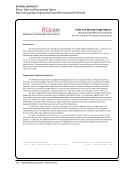12 · Survey Results: Executive Summary
managing born-digital content. Almost all have used
a combination of strategies, either adding that respon-
sibility to existing positions (94%) or recasting an ex-
isting position (37%), and creating new positions (46%).
Training strategies reflect the emphasis on retooling
the skill sets of existing positions. Conferences, on-
the-job training, workshops, and independent study
are the primary methods staff use to develop their
expertise with born-digital content.
Born-Digital Materials Collected
Almost all of the responding libraries (54 or 84%) are
currently collecting electronic theses and disserta-
tions. The majority also collect personal archives and
institutional records and archives. Most of the others
report they plan to collect these categories of materi-
als. Twenty-one libraries collect research data and 28
others plan to collect it. Photographs, audio and video
recordings, texts, and moving images are the most
frequently collected media formats. About a third of
the respondents collect websites, email, and databases
almost an equal number plan to collect these formats.
While only six currently collect social media, 23 others
plan to do so in the future.
Ingest Policies and Procedures
The majority of respondents (45 or 71%) have not de-
veloped gift/purchase agreement language that is
specific to born-digital materials, but many are re-
viewing those agreements. Thirty-six respondents
(56%) reported that they have developed ingest and
processing workflows. An analysis of the comments
indicates that a number of libraries are in the devel-
opment phase. The comments also revealed a variety
of models and/or examples the libraries have used in
the development of workflows. These influences can
be grouped into nine general categories as seen in the
chart below.
Projects that influenced workflow development
include the Personal Archives Accessible in Digital
Media (PARADIGM) and futureArch projects at
the University of Oxford’s Bodleian Library, the
AIMS project (Born Digital Collections: An Inter-
Institutional Model for Stewardship) conducted by
Stanford University, Yale University, University of
Virginia, and University of Hull (UK), InterPARES,
the British Library’s Digital Lives project, the Tufts
Accessioning Program for Electronic Records
(TAPER) project, the European Union’s Preservation
Conferences 1% Policy Mandates 5%
Repository Software 6%
Information from
Professional Organizations 7%
Local Needs 10%
Emerging Digital
Preservation Standards 11%
Peer Institutions 18%
Tools &Software Resources 19%
Research Projects &Groups 23%
Influences on the Development of Ingest and Processing Workflows
managing born-digital content. Almost all have used
a combination of strategies, either adding that respon-
sibility to existing positions (94%) or recasting an ex-
isting position (37%), and creating new positions (46%).
Training strategies reflect the emphasis on retooling
the skill sets of existing positions. Conferences, on-
the-job training, workshops, and independent study
are the primary methods staff use to develop their
expertise with born-digital content.
Born-Digital Materials Collected
Almost all of the responding libraries (54 or 84%) are
currently collecting electronic theses and disserta-
tions. The majority also collect personal archives and
institutional records and archives. Most of the others
report they plan to collect these categories of materi-
als. Twenty-one libraries collect research data and 28
others plan to collect it. Photographs, audio and video
recordings, texts, and moving images are the most
frequently collected media formats. About a third of
the respondents collect websites, email, and databases
almost an equal number plan to collect these formats.
While only six currently collect social media, 23 others
plan to do so in the future.
Ingest Policies and Procedures
The majority of respondents (45 or 71%) have not de-
veloped gift/purchase agreement language that is
specific to born-digital materials, but many are re-
viewing those agreements. Thirty-six respondents
(56%) reported that they have developed ingest and
processing workflows. An analysis of the comments
indicates that a number of libraries are in the devel-
opment phase. The comments also revealed a variety
of models and/or examples the libraries have used in
the development of workflows. These influences can
be grouped into nine general categories as seen in the
chart below.
Projects that influenced workflow development
include the Personal Archives Accessible in Digital
Media (PARADIGM) and futureArch projects at
the University of Oxford’s Bodleian Library, the
AIMS project (Born Digital Collections: An Inter-
Institutional Model for Stewardship) conducted by
Stanford University, Yale University, University of
Virginia, and University of Hull (UK), InterPARES,
the British Library’s Digital Lives project, the Tufts
Accessioning Program for Electronic Records
(TAPER) project, the European Union’s Preservation
Conferences 1% Policy Mandates 5%
Repository Software 6%
Information from
Professional Organizations 7%
Local Needs 10%
Emerging Digital
Preservation Standards 11%
Peer Institutions 18%
Tools &Software Resources 19%
Research Projects &Groups 23%
Influences on the Development of Ingest and Processing Workflows










































































































































































































